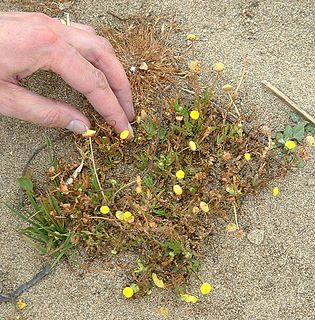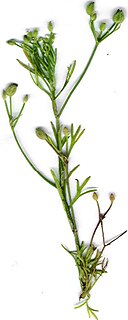Related Research Articles

Solidago, commonly called goldenrods, is a genus of about 100 to 120 species of flowering plants in the aster family, Asteraceae. Most are herbaceous perennial species found in open areas such as meadows, prairies, and savannas. They are mostly native to North America, including Mexico; a few species are native to South America and Eurasia. Some American species have also been introduced into Europe and other parts of the world.

Arctotis is a genus of annual and perennial plants in the family Asteraceae.

Conyza is a genus of flowering plants in the sunflower family.

Symphyotrichum is a genus of over 90 species of herbaceous annual and perennial plants in the composite family (Asteraceae) that were formerly treated within the genus Aster. The majority are endemic to North America, but several species also occur in the West Indies, Central and South America, as well as in eastern Eurasia. Many species have been introduced to Europe as garden specimens, most notably New England aster and New York aster.

Astereae is a tribe of plants in the family Asteraceae that includes annuals, biennials, perennials, subshrubs, shrubs, and trees. Plants within the tribe are present nearly worldwide divided into 170 genera and more than 2,800 species, making it the second-largest tribe in the family behind Senecioneae. They are found primarily in temperate regions of the world.

Cotula is a genus of flowering plant in the sunflower family. It includes plants known generally as water buttons or buttonweeds.
Pentzia is a genus of African plants in the chamomile tribe within the sunflower family. One species (P. incana) is naturalized in Australia and in the southwestern United States.

Pluchea is a genus of flowering plants in the stinkwort tribe within the sunflower family.
Laennecia or Laënnecia is a genus of flowering plants in the sunflower family. The plants are native to Mesoamerica, South America, and the southwestern United States. Common name is "horseweed."

Mairia is a genus of perennial herbaceous plants assigned to the daisy family. All species have leathery, entire or toothed leaves in rosettes, directly from the underground rootstock, and one or few flower heads sit at the top of the stems that carry few bracts. These have a whorl of white to mauve ray florets surrounding yellow disc florets in the centre. In general, flowering only occurs after the vegetation has burned down. The six species currently assigned to Mairia are endemic to the Western Cape and Eastern Cape provinces of South Africa. Some of the species are called fire daisy in English and vuuraster in Afrikaans.

Archibaccharis is a genus of flowering plants in the daisy family.
Guy L. Nesom is an American writer and botanist.
Mairia is a genus of African flowering plants in the aster tribe within the sunflower family.

Erythranthe, the monkey-flowers and musk-flowers, is a diverse plant genus with at least 111 members in the family Phrymaceae. Erythranthe was originally described as a separate genus, then generally regarded as a section within the genus Mimulus, and recently returned to generic rank. Mimulus sect. Diplacus was segregated from Mimulus as a separate genus at the same time. Mimulus remains as a small genus of eastern North America and the Southern Hemisphere. Molecular data show Erythranthe and Diplacus to be distinct evolutionary lines that are distinct from Mimulus as strictly defined, although this nomenclature is controverisal.

Diplacus is a plant genus in the family Phrymaceae, which was traditionally placed in family Scrophulariaceae. In the 2012 restructuring of Mimulus by Barker, et al., based largely upon DNA evidence, seven species were left in Mimulus, 111 placed into Erythranthe, 46 placed into Diplacus, two placed in Uvedalia, and one each placed in Elacholoma, Mimetanthe, and Thyridia. Diplacus used to be a separate genus from Mimulus but no later than 1905, it was merged into Mimulus until the 2012 restructuring. Dry and rocky areas are preferred.

Spermolepis is a genus of flowering plants belonging to the family Apiaceae.
References
- 1 2 3 Flann, C (ed) 2009+ Global Compositae Checklist
- ↑ lectotype designated by Nesom, Guy L. 1994. Phytologia 76(2):92
- ↑ Lessing, Christian Friedrich. 1832. Synopsis Generum Compositarum Earumque Dispositionis Novae Tentamen Monographiis Multarum Capensium Interjectis 185
- ↑ Tropicos, Gymnostephium Less.